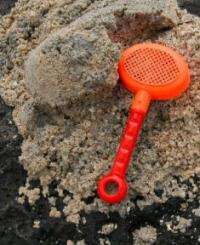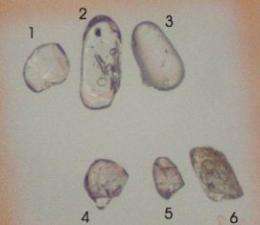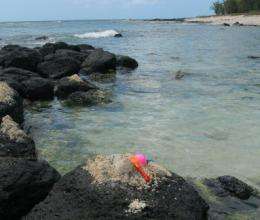Rare particles give clue to ancient Earth

(Phys.org) —Semi-precious minerals found in a bucket of sand from an island nation have cracked open a clue to the drifting movements and break-up of ancient Earth's massive continental plates.
The particles are zircons and the island – Mauritius – is now thought to be hiding a micro-continent which has been given the name Mauritia.
Zircons can be as old as four billion years and are almost never found in oceans, proving the likelihood that Mauritius sits on top of a fragment of continental plate which remained behind and was covered by huge masses of lava when Madagascar split apart from India about 90 million years ago.

Prof. Lewis Ashwal from Wits University studies the break-up process of continents. He was part of the group of geoscientists from Norway, South Africa, Britain and Germany who recently announced their finding of zircons in Mauritius. They've been working in the area for 15 years.
The break-up of continents is often associated with mantle plumes. These giant bubbles of hot rock rise from the deep mantle and soften the tectonic plates from below, until the plates break apart at the hotspots. This is how Eastern Gondwana broke apart about 170 million years ago. At first, one part was separated, which in turn fragmented into Madagascar, India, Australia and Antarctica, which then migrated to their present position.
A deep mantle plume, currently situated underneath the island of Reunion, was once situated under Mauritius and appears to have played a role in the emergence of the Indian Ocean. If the zone of the rupture lies at the edge of a land mass (in this case Madagascar/India), fragments of this land mass may be separated off. The Seychelles are a well-known example of such a continental fragment.

Ashwal and others are suggesting, based on the study of lava sand grains from the beach of Mauritius, the existence of further fragments. The sand grains contain zircons aged between 660 and 1 970 million years, which is explained by the fact that the zircons were carried by the lava as it pushed through subjacent continental crust of this age.
According to Ashwal, there are two kinds of territory in the world – continent and ocean, and each sovereign piece of continent has the right to claim 20 nautical miles beyond its ocean borders for fishing, mining, oil and other rights.
There are great implications for Mauritius if it can be shown to be a continent, and if that piece of continental plate stretches beyond the borders of the island, extending the country's claim to the ocean territory around it, possibly all the way up to the Seychelles.
Provided by Wits University




















